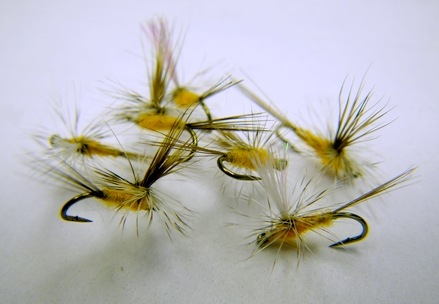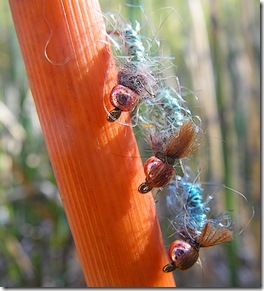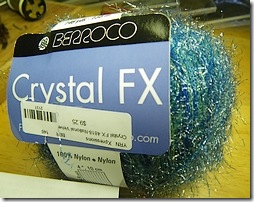This winter I’ll be busy restocking tiny and gossamer, as each trip has required both small and unique dry flies. With failing vision it’s not realism that’ll motivate the sizes and patterns needed, it’ll be small yet visible as the requirement.
Both trips North featured few organized hatches, and the evening grab was comprised of a smorgasbord of terrestrial and aquatic insects, some struggling in the surface film, and the rest emerging per schedule.
Ants and midges are my top priority, using Redditch Scale hooks they would be #18 or #20, as I can’t see smaller at distance (Mustad & Tiemco aren’t using the Redditch Scale, so they would be #20 and #22).
Early in the year it was a Mustard-Orange midge that was needed, and this weekend featured a newer variant in Key Lime Pie – which will play havoc with the traditional somber bug colors, but will be fun to tie – and even more fun explaining to the curious …

The Mustard-Orange Midge above (Redditch #18) was consistent with the emerging midges, it accounted for all surface casualties.Tied in traditional mayfly-parachute style so it doesn’t disappear in the surface film like more traditional down-wing midge patterns. Dun gray deer hair wing, grizzly hackle and tail, and Singlebarbed’s Yellow Orange dry fly dubbing…
… I threw that in just so you’d clutch chest and exclaim, “Crap, I ain’t got none …”
Any dubbing the color of natural orange juice will work fine. Picture the above with a Key Lime body and you’d have the latest variant covered nicely.
I tied half with white wings and half with dun deer hair. The white wing shows better when contrasted against the darker water of evening, and the dun deer hair shows better contrast against light colored water backlit by the sun. Tiny flies and diminishing eyesight means any trick is fair game.
Early in the season the ants were enormous, this weekend they were just as plentiful, only small – in sizes #18 and #20. I struggle with how I’m going to make the smallish-black visible to my old eyes, but it will likely feature a mayfly upwing just so I can pick it out from among the naturals. Ants aren’t graceful in death, nor are wings precisely folded. I should be able to poke something skyward that I can see, without compromising realism.

The top fish getter for Hat Creek was something I’d tied for the brown water. A simple bead headed caddis worm tied in a frosty blue/green, compliments of Berrocco’s Crystal FX yarn, in an odd color called National Velvet.
It’s a multicolor yarn, predominantly blue, that fades into a blue green, then back to light blue.
I’d read that trout lack the cones for blue, so I’d dismissed it as a trout fly, and intended to use it for Carp and Pikeminnow.
When wet the yarn color trends to blue green, which proved irresistible to wild trout.
If the ability to resolve blue is an issue, I would guess the fly was a neutral hue that retained the green elements, coupled with a light halo of transparent mylar fuzz that gives the yarn its signature look.
 That was as much science as I contemplated, as the fish were eating it fast and furiously, and Kelvin was fingering my box for spares.
That was as much science as I contemplated, as the fish were eating it fast and furiously, and Kelvin was fingering my box for spares.
Berrocco discontinued the yarn in 2007, but you can still purchase it on eBay, there’s five skeins of National Velvet available.
There’s little question this has been a strange year. Intense and prolonged rain upset everything from the tomato harvest to hatch timetables. A lot of the odd insects encountered recently may be hatching early or late compared to last year, which explains why I’ve not seen them before.
With that in mind I’ll not go overboard in stocking up, perhaps a dozen of each color tossed into a single compartment should next year be more of the same.

You devil, you! A link to a Wally Market ad for yogurt instead of another party colored fly. Good, good, good.
I need a good laugh every day, because lately the Stripers have not been attracted to my offerings. Yet.
If you look at the yogurt label at the color of the Key Lime, that’s what you need to make those midges resemble.
I was just making sure you were awake.
…. ummmmm … 4 skeins available.
I tried not to be greedy, unlike some of these people I’m seeing sell the Harlee hooks for $8.99 per hundred (plus shipping).
I wondered if the Greatest Hook Sale of All Time was going to spawn a lot of that. Doesn’t surprise me one bit.
Great Keith, I haven’t even used the mohair yarn you turned me on to and now I’m out 10 bucks for this blue stuff!
I like the beadheads with wing cases pulled over the top. I’ve never seen that before.
I do that to reduce shine mostly. I’ve always wondered whether the bead itself could be too shiny (especially on a bright day), so I fiddle around with ways to preserve the weight – yet mask the glare of the bead.
What about using a sharpie. Then if the sun goes back behind the clouds, you could just rub it off?
Not that I’m trying to cramp your artistic style.
You may be incorrect in noting that trout don’t see blue. One web source suggests that trout have the MOST visual acuity and sensitivity to blue light. See: http://www.sexyloops.com/articles/whatsalmonidssee.shtml
@Sparsehackle – you appear correct sir.
“Trout and salmon can see all of the colours that we can, but whilst our eyes are most sensitive in the green area of the spectrum, the trout’s eye can discriminate best in the blue region.”
Which was verified by another scientific source. I remember reading something about blue cones and trout – but I’ve obviously confused it with something else.
Thanks for the clarification.
Now I am properly curious, if so, why are blue trout flies so scarce? I can think of only a couple of old wet flies that are blue …